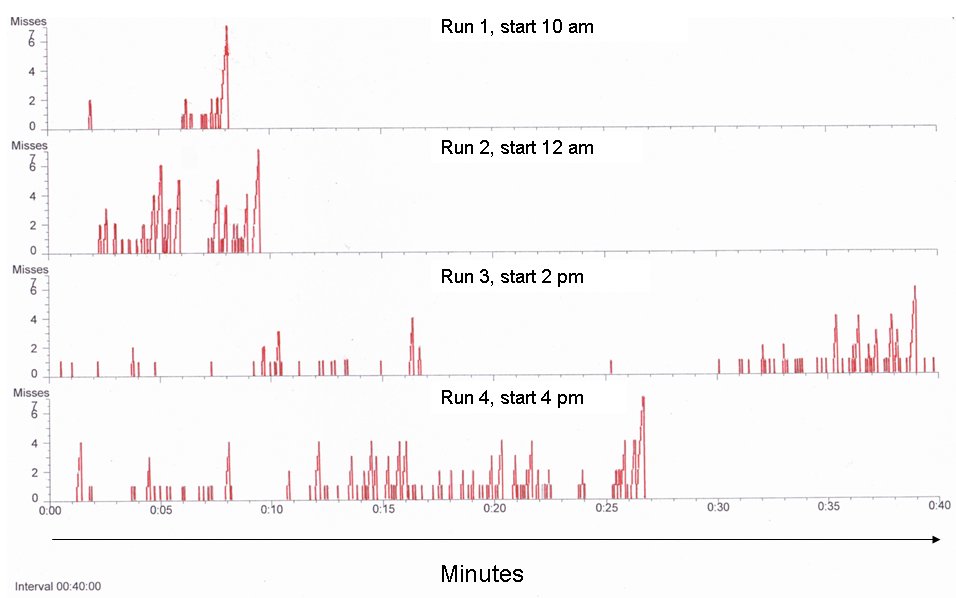Contributed by Irène Laube, MD, Pulmonary Department, Stadtspital Triemli, Zurich, Switzerland and Robert Thurnheer, MD, Pulmonary Department, Kantonsspital Munsterlingen, Switzerland
A 47-old male obese (BMI 33.4 kg/m2) lorry driver had an accident due to microsleep while driving. He was referred for further evaluation of sleep apnea syndrome. He denied excessive daytime sleepiness. His Epworth sleepiness scale (ESS) was normal with 5 out of 24 points (normal ≤ 10 points). The tendency to fall asleep was objectively evaluated by an Oxford Sleep Resistance test (OSLER test). The figure shows the results of four consecutive 40 minutes OSLER tests (runs 1 to 4) performed in 2 hour intervals during daytime. Failure to respond to a flashlight is recorded as missed”.
How do you interpret the results of the test and what is your conclusion regarding the patients’ ability to drive?
The patient fell asleep during three out of four test episodes and should be suspended from driving a motor vehicle until CPAP therapy has been installed and improvement of objectively assessed daytime sleepiness has been documented.
Mean sleep latency of the 4 tests was 21 minutes thus the ability to stay awake in monotonous situations is markedly reduced in this patient. Moreover, many episodes of possible microsleep can be expected in runs two to four. In contrast to the MSLT, only few data on normal values of MWT and OSLER test are available.
However, for a professional driver, falling asleep on three occasions during daytime seems unacceptable. Experts have advocated limits of mean sleep resistance times of >30 or even 40 minutes as a prerequisite for professional drivers.
This patient was diagnosed with severe obstructive sleep apnea (AHI 87 hr-1, ODI 91 hr-1) and treatment with CPAP was started. Follow-up assessment of objective sleepiness by OLSER tests demonstrated a normal ability to stay awake in monotonous situations (sleep latency >40min).
EDS can be assessed subjectively by visual scales or questionnaires, the best known being the “Epworth Sleepiness Scale” (ESS, range of 0-24 points, normal ≤10 points). This test is merely based on subjective judgement and may correlate better with health status than with objectively measured sleepiness. Objective tests in sleepy patients assess for sleep-wake balance disturbances, the most widely used tests are the Multiple Sleep Latency Test (MSLT) and the Maintenance of Wakefulness Test (MWT). Both tests are objective measures of an individual’s ability to fall asleep (MSLT) or to stay awake (MWT), respectively. The MWT has also clinical usefulness in evaluating response to treatment following intervention for conditions associated with EDS, and in assessing individuals who must remain awake for safety reasons. A pathological MWT mean sleep latency has been shown to be associated with impaired driving simulator performance (1).
MSLT and MWT are time consuming and expensive, which may limit their use in daily clinical practice. A simple alternative method to objectively assess the tendency to fall asleep is the OSLER test first described 1997 by Bennett et al (2). The test measures the ability to stay awake similar to the MWT and can be used as a practical and reliable tool for evaluating daytime sleepiness. After a normal night of sleep the subject performs a 40 minutes sleep resistance challenge. Some experts recommend to perform 4 tests in 2-hour intervals throughout the day in order to increase the sensitivity of the test. Subjects are encouraged to remain awake but are not allowed to use any external stimuli. During the OSLER test subjects are asked to press a button in response to a light which is lit repetitively for 1 second. When the subject fails to respond to 7 sequent illuminations corresponding to 21 s (approximately duration of 1 sleep epoch), it is assumed that the subject has fallen asleep and the test is terminated.
In a validation study, sleep latencies for the OSLER and MWT were closely correlated (ICC [Intra-class correlation] = 0.94, p < 0.05). Sleep latencies by OSLER and simultaneous measurement of EEG also showed excellent agreement (ICC = 0.91) with a bias of -0.97 min. Furthermore, no obvious systematic adaptation is seen during sequential OSLER test performance (3). Single missed stimuli are frequent with or without microsleep. Data from Priest et al. demonstrated that already 3 consecutive misses (>7s) correspond to microsleep in 92%, and 4 or more misses correspond to microsleep in 95%, respectively (4). However, neither the MWT nor the OSLER test has been validated to identify drivers at increased risk for traffic accidents.
Recommendations and regulations for the practical approach of a physician facing a sleepy driver differ between countries; however, objective data to predict the overall risk of a driver to be involved in vehicle crashes are scant. Therefore, other aspects than objective sleepiness such as a driver’s awareness of drowsiness, fatigue and sleepiness as well as a sensible and responsible behaviour are necessary to judge the patients driving capability. In uncertain cases, a battery of sleepiness and vigilance tests, neurological, psychiatric and neuropsychological function including risk taking behaviour must be evaluated in a multidisciplinary approach.
References:
- Sagaspe P, Taillard J, Chaumet G, Guilleminault C, Coste O, Moore N, Bioulac B, Philip P. Maintenance of wakefullness test as a predictor of driving performance in patients with untreated obstructive sleep apnea. Sleep 2007; 30:327-30
- Bennett LS, Stradling JR, Davies RJ. A behavioural test to assess daytime sleepiness in obstructive sleep apnoea. J Sleep Res 1997; 6: 142-5
- Krieger AC, Ayappa I, Norman RG, Rapaport DM, Walsleben J. Comparison of the maintenance of wakefulness test (MWT) to a modified behavioral test (OSLER) in the evaluation of daytime sleepiness. J Sleep Res 2004; 13: 407-11
- Priest B, Brichard C, Aubert G, Liistro G, Rodenstein DO. Microsleep during a simplified maintenenance of wakefulness test. A validation of the OSLER Test. Am J Resp Crit Care Med 2001; 163: 1619-25
- Wise MS. Objective measures of sleepiness and wakefulness: application to the real world? J Clin Neurophysiol. 2006 Feb;23:39-49




